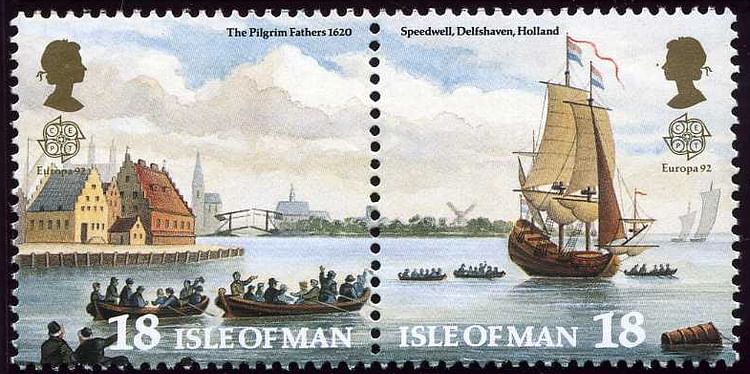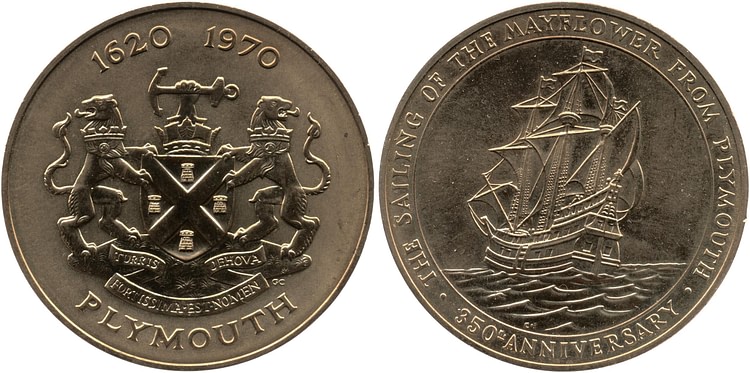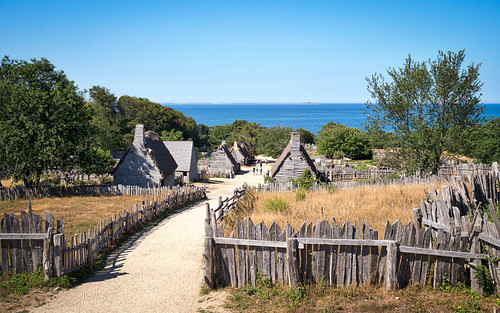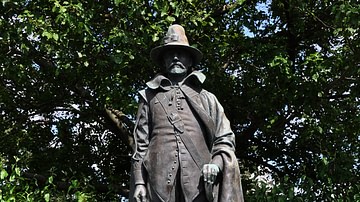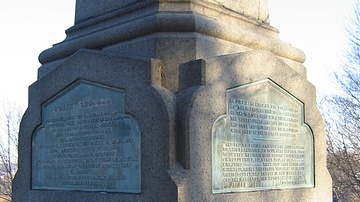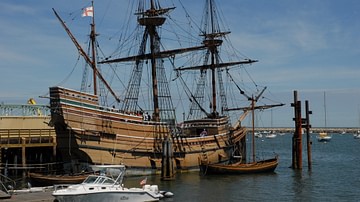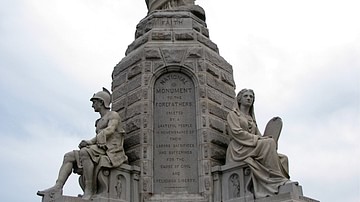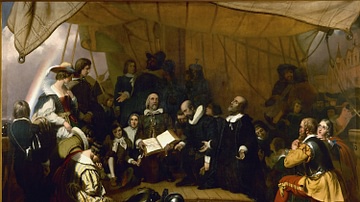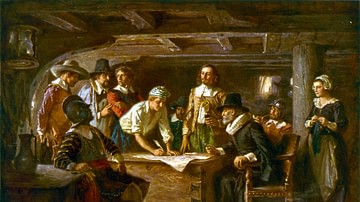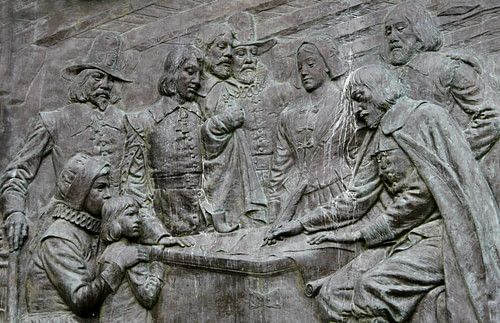
John Carver (l. 1584-1621 CE) was one of the leaders of the Mayflower expedition, first signer of the Mayflower Compact, and first governor of Plymouth Colony. He was a prominent member of the separatist congregation of Leiden, the Netherlands, and sailed with them aboard the Mayflower after serving as chief negotiator (along with another congregant, Robert Cushman, l. 1577-1625 CE) with the Virginia Company and the merchant adventurer Thomas Weston (l. 1584 - c. 1647 CE) in procuring a patent for the colony and outfitting the expedition to the New World.
Carver seems to have performed the duties of governor of the Mayflower along with another man, not of the congregation (one of the so-called Strangers), Christopher Martin (l. c. 1582 - winter of 1620/1621 CE) who was generally mistrusted and disliked by the other passengers, especially the separatists, for his arrogance and perceived mismanagement of funds. Carver was most likely the author of the Mayflower Compact, composed and signed before anyone left the ship in the New World. Martin may have believed that he would be elected the first governor of the colony, but that honor went quickly to Carver.
In his time as governor, Carver assigned work details, sent out exploratory missions, helped build shelters, all while surviving the harsh winter of 1620-1621 CE, and afterwards, with Edward Winslow (l. 1595-1655 CE), negotiated a peace treaty and trade agreement with the chief Massasoit (l. c. 1581-1661 CE) of the Wampanoag Confederacy. He died in April 1621 CE, possibly of heatstroke or leptospirosis, and was buried with full honors at Coles Hill, Plymouth. He was succeeded as governor by William Bradford (l. 1590-1657 CE) who has been frequently, and inaccurately, regarded as the first governor of Plymouth Colony though this trend has been reversed by modern-day scholarship.
Carver & the Leiden Congregation
Almost nothing is known of Carver's life before his involvement with the separatist congregation of Leiden. He was married to a woman named Mary (or Martha) who died, along with their only child, in 1609 CE. He then married Katherine White, daughter of Alexander White (probable brother of William White, l. c. 1580 - winter of 1620/1621 CE), who would accompany him on the Mayflower.
The separatists of Leiden were English citizens and Protestant fundamentalists who had fled from a policy of religious persecution in their homeland carried out by the Anglican Church under the direction of King James I of England (r. 1603-1625 CE). They had been an established congregation in Scrooby, England, led by their pastor John Robinson (l. 1576-1625 CE) until 1607 CE when the persecutions grew worse and they relocated to the Netherlands where the government was more tolerant of religious diversity. Carver greatly admired Robinson and devoted himself to the welfare of the congregation, becoming a deacon in 1609 CE in order to better serve the peoples' needs.
In 1618 CE, William Brewster (l. 1568-1644 CE), a leading member of the congregation, published a tract critical of the Anglican Church and so, by extension, of James I of England, and orders were given for his arrest. The congregation hid Brewster but recognized the urgency to relocate in order to live and worship freely without fear of persecution. A plan was already in place to establish a colony in the New World prior to Brewster's publication due to the living conditions of the English congregation living in Leiden. Well-paying jobs in the Netherlands were controlled by guilds which, as foreigners, the separatists were ineligible for. They already understood, therefore, that they needed to leave, but the Church's move against Brewster pressed the issue.
Chief Negotiator with Cushman
John Carver and Robert Cushman were tasked with negotiating the details of procuring a patent and outfitting the expedition. England had established its first successful colony at Jamestown, Virginia in 1607 CE, and by 1617 CE, it was thriving, primarily due to its cash crop of tobacco. Carver and Cushman contacted the Virginia Company of London, the same which had invested in Jamestown, for their patent in 1617 CE and negotiated with the merchant adventurer Thomas Weston to supply them with ships and crew.
These negotiations did not always go smoothly. Weston matched investors who expected to turn a profit with those who planned to found colonies in the New World and, to that end, required a number of people accompany the separatists who were not of their faith (those whom the “Saints” of the Leiden congregation, as they called themselves, would refer to as Strangers) in order to help establish a profitable colony quickly. Weston was not interested in the saint's religious beliefs, personal plans, or what differences various members of the congregation might have with the Strangers. Carver and Cushman had to take all of these aspects into account in putting together the expedition since they could not compromise their faith in dealing with Weston – who appears to have been a less than honorable man – but could not refuse his demands and, at the same time, had to consider the wishes of the congregation they represented.
In his letters, Weston complains that the congregation would have a much easier time if they were not so rigid. Cushman, negotiating in London, tried to appease Weston while also making sure his actions were approved by the congregation at Leiden. Carver, in his letters from Southampton where he was negotiating, attacked Cushman for negligence in his dealings with Weston, pointing out that Cushman was spending too much and demanding too little and Weston contributing too little and asking too much.
William Bradford, in his Of Plymouth Colony, reprints the letters between the men which make clear how contentious the relationship between Carver, Cushman, and Weston became. Carver, correctly, kept noting how little money the congregation had and how important it was to get the lowest price; Weston did not care how much they could afford and only wanted to outfit a profitable colonizing effort; Cushman was caught between in trying to take into account both sides' arguments. Right up to the point of departure, the three continued to argue and it is thought that the stress of the negotiations, and the congregation siding with Carver in the argument, caused the illness which eventually led to Cushman removing himself from the 1620 CE voyage.
Departure & Voyage
The expedition was supposed to travel in two ships – the Speedwell, a passenger vessel, and the Mayflower, a cargo carrack – but the Speedwell leaked and had to be abandoned. At this point, Cushman and a number of others who had been on the Speedwell decided to stay behind, and the Mayflower took on those who would continue. Prior to departure, Carver oversaw or was involved in the sale of various commodities and valuables to cover the pilgrims' debt to Weston and other merchants, which seems to have raised suspicions among the colonists regarding Christopher Martin and financial impropriety. Martin was supposed to have purchased certain necessaries, claimed that he had, but failed to produce them. Even so, he was assigned to the Mayflower as its governor, though it seems Carver, who had been governor of the Speedwell, actually performed that duty or, at least, was more popular in administrating aboard ship than Martin.
The Mayflower's departure was highly emotional as many families would be separated and, as far as they knew, possibly forever. A number of men – both pilgrims and Strangers – traveled alone to help establish the colony and planned to send for their families later, while others were leaving behind brothers, mothers, sisters, and fathers who planned on coming the following year, and then there were still others who had planned on traveling on the Speedwell who would now have to wait in Leiden.
Carver sailed on the Mayflower with his wife Katherine and their servants (probably five in all, including one named Dorothy) and a young charge they had been given, Jasper More, one of four children surrendered by their father to the colonists. The Mayflower was not built for passengers and space on the gun deck (known as the `tween deck as it was between the main and cargo), where they would travel, had already been cramped before the addition of those from the Speedwell.
The passengers traveled in near-darkness and close quarters with at least two dogs, goats, chickens, a number of children, and the various resentments between the separatists – who had thought they would be traveling as a single unit – and the Strangers who had joined them. Carver, as ship's governor, would have had to have found some way of keeping peace between the two groups and, apparently, did so, although no details are given by Bradford's later account. The claim that Carver, not Martin, was effectively the Mayflower's governor is supported by his later election, aboard ship, as governor of the colony as well as the passages from Bradford's work, and others, concerning Martin's unpopularity.
The first part of the voyage seems uneventful, but the latter half saw rough seas and high winds. The ship was blown off course, the central beam cracked and had to be repaired, the passengers would have been almost continuously wet from waves washing over the main deck and spilling onto their heads. When land was finally sighted on 9 November 1620 CE, it must have been a great relief until it was understood that they were nowhere near their destination and had arrived in a region where they could expect no help. Captain Jones tried sailing south to their original destination, but bad weather and low supplies caused him to turn around and return to the area around modern-day Provincetown, Massachusetts.
Mayflower Compact
The Mayflower was supposed to have landed in the English Virginia colony above Jamestown and below present-day New York State which was then controlled by the Dutch to the north but to the south was part of the Virginia patent. Believing they would be near enough other settlements to trade for what they needed and ask for assistance when required, they had not brought many items they now found they would need (such as fishing poles and tackle) and many others now useless (over 200 pairs of shoes to be sold). Just as importantly, they were supposed to have landed where English law was already in place while the coast they looked out on from the Mayflower's deck was complete wilderness.
The region was known to Captain Jones and his crew and also to the passengers who had bought maps of North America while planning the expedition. Captain John Smith (l. 1580-1631 CE), of Jamestown fame, had mapped the area in 1614 CE and had even named part of the bay they now floated in New Plymouth. Even so, no colony had been established there, and some of the Strangers aboard openly declared that, since there was no law, they would do as they pleased in the new land and it would be every man for himself.
In order to counter this, the Mayflower Compact was composed, a legal agreement to be signed by all stating that they would enact democratically agreed upon laws and abide by them for the common good. There is no account identifying whose idea it was to craft this agreement, but it would become vital to the colony's survival and serve as a model for later similar legislation in the United States of America in establishing a democratic system of government. Carver is thought to have composed the piece which was then signed by all 41 males present; only afterwards did Carver allow anyone to leave the ship, and the Mayflower dropped anchor on 11 November 1620 CE.
First Winter & the Native Americans
Carver sent an expedition of 16 men, including Myles Standish (l. c. 1584-1656 CE) and Stephen Hopkins (l. 1581-1644 CE) to scout for a suitable place along the coast for the settlement. The men traveled around the bay in a small boat known as a shallop, on rough waters and near-freezing conditions. On 8 December 1620 CE, they were attacked by natives of the Nauset tribe in what has been called the First Encounter. No one was injured on either side, but they understood they should expect no help from the indigenous people. The Nauset, however, were only responding to what they had come to recognize as a threat since they had already experienced European expeditions to their lands which resulted in many of them being kidnapped and sold into slavery and others dying of European-borne disease.
The men returned to the Mayflower with their report of a site at John Smith's New Plymouth which seemed best, and the Mayflower crossed the bay to anchor there. It was only at this point that women and children were allowed to leave the ship and finally wash their clothes on the beach but, at the same time, allowed for more to forage for food on land. A number of them ate green mussels they found in the water and came down with food poisoning while others are thought to have taken water from stagnant ponds and possibly developed leptospirosis. Whatever the many causes may have been – including lack of nutrition, exposure to the cold, scurvy – many of the passengers and crew became ill, and only 50% of them would survive the first winter.
Carver assisted in planning the settlement, which began along Leiden Street (present-day Leyden Street, Plymouth) and building the homes as well as commissioning Myles Standish to plan and build a fort for protection against attacks by natives. The next Native American they encountered, however, came in peace and would change their fortunes. This was Samoset (also given as Somerset, l. c. 1590-1653 CE) who greeted them in English and later introduced them to Tisquantum (better known as Squanto, l. c. 1585-1622 CE) who would teach them how to survive in the New World.
Squanto was fluent in English which he learned after being kidnapped to be sold into slavery when he was young. He escaped, made his way to England, and returned to his native land c. 1614 CE to find that his people had all died from disease. Squanto acted as interpreter between the colonists and Massasoit of the Wampanoag Confederacy. Carver and Edward Winslow, with Squanto's help, established the peace treaty with Massasoit which guaranteed the survival of the colony through trade, cordial relations, and mutual defense against common enemies.
Conclusion
Contrary to popular legend, Massasoit did not enter into the contract out of the goodness of his heart nor because he was unaware of what the English were like. The tribes of the Wampanoag Confederacy had been reduced by diseases, and by 1621 CE they were weaker than their rivals in the area, the Narragansetts. Massasoit wanted these new English, with their iron knives and axes, as his allies to strengthen his position, which, in fact, the treaty would do. Carver and Winslow were not only hoping to survive in the New World but turn a profit for the investors and, through the fur trade that was established, they succeeded in both goals.
John Carver died less than a month after signing the treaty of unknown causes. Bradford reports that he was working in his field on an exceptionally hot day in April when he complained of a headache and returned home to rest, dying later. His wife, Katherine, did not survive him long; Bradford notes that they were devoted to each other, and it was believed she died of a broken heart.
Prior to the arrival of Samoset and Squanto, and the treaty with Massasoit, the settlers had buried their dead at night without ceremony, not wishing to attract attention or let the natives know how many people had been lost. When Carver died, however, he was given full honors in broad daylight and mourned deeply. William Bradford was then elected governor of Plymouth Colony and his long term, as well as his famous account, would overshadow Carver's accomplishments.
Even though Bradford has regularly been referenced as the first governor for centuries, Carver has always been recognized as one of the most significant of the early Plymouth settlers. According to Bradford himself, Carver's gentle and democratic spirit helped shape and guide the early colony as its first governor, and modern scholarship now makes a point of echoing Bradford's estimation of Carver and recognizing his achievements fully.
